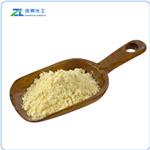- Oxytetracycline HCl
-

- $120.00 / 1kg
-
2025-03-28
- CAS:2058-46-0
- Min. Order: 1kg
- Purity: 99%
- Supply Ability: 20ton
|
| | Oxytetracycline hydrochloride Basic information |
| | Oxytetracycline hydrochloride Chemical Properties |
| Melting point | 180°C | | alpha | -188~-200°(D/20℃)(c=1,0.1mol/l HCl) (calculated on the dried basis) | | storage temp. | 0-6°C | | solubility | Freely soluble in water, sparingly soluble in ethanol (96 per cent). Solutions in water become turbid on standing, owing to the precipitation of oxytetracycline. | | form | crystalline | | color | yellow | | PH | 2.0~3.0 (10g/l, 25℃) | | optical activity | [α]/D -190 to -200°, c =1 in 0.1 M HCl (anhydrous basis) | | Water Solubility | >100 g/L | | Sensitive | Light Sensitive | | λmax | 360nm(H2O)(lit.) | | Merck | 14,6976 | | BRN | 3853107 | | Stability: | Hygroscopic | | CAS DataBase Reference | 2058-46-0(CAS DataBase Reference) | | EPA Substance Registry System | Oxytetracycline hydrochloride (2058-46-0) |
| Hazard Codes | Xn,Xi | | Risk Statements | 63 | | Safety Statements | 45-53-36/37/39 | | WGK Germany | 2 | | RTECS | QI8225000 | | F | 8-10-23 | | TSCA | Yes | | HS Code | 29413000 | | Toxicity | LD50 oral in mouse: 6696mg/kg |
| | Oxytetracycline hydrochloride Usage And Synthesis |
| Description | Oxytetracycline is a tetracycline analog isolated from the actinomycete Streptomyces rimosus. Oxytetracycline is an antibiotic indicated for treatment of infections caused by Gram positive and Gram negative microorganisms such as Mycoplasma pneumoniae, Pasteurella pestis, Escherichia coli, Haemophilus influenzae, and Diplococcus pneumoniae. It is used in studies on the oxytetracycline-resistance gene (otrA). Oxytetracycline hydrochloride is used to study phagosome-lysosome (P-L) fusion in P388D1 cells and antibiotic susceptibilities of Mycoplasma bovis isolates. | | Chemical Properties | Yellow Crystalline Solid | | Originator | Terramycin,Pfizer,US,1950 | | Uses | Antibiotic substance isolated from the elaboration products of the actinomycete, Streptomyces rimosus, grown on a suitable medium. Antibacterial | | Uses | Oxytetracycline is an antibiotic indicated for treatment of infections caused by Gram positive and Gram negative microorganisms such as Mycoplasma pneumoniae, Pasteurella pestis, Escherichia coli, Haemophilus influenzae, and Diplococcus pneumoniae. It is used in studies on the oxytetracycline-resistance gene (otrA). Oxytetracycline hydrochloride is used to study phagosome- lysosome (P-L) fusion in P388D1 cells1 and antibiotic susceptibilities of Mycoplasma bovis isolates. | | Uses | Oxytetracycline hydrochloride is a salt prepared from oxytetracycline taking advantage of the basic dimethylamino group which protonates readily to form the salt in hydrochloric acid solutions. The hydrochloride is the preferred formulation for pharmaceutical applications. Like all tetracyclines, oxytetracycline shows broad spectrum antibacterial and antiprotozoan activity and acts by binding to the 30S and 50S ribosomal sub-units, blocking protein synthesis. | | Definition | ChEBI: Oxytetracycline hydrochloride is an organic molecular entity. | | Manufacturing Process | The pH was adjusted to 7.0 with sodium hydroxide and calcium carbonate was added at the rate of 1 g/l.
500 ml portions of the above medium were added to Fernbach flasks which
were then sterilized at 121°C for 30 minutes. Upon cooling, the flasks were inoculated with a suspension of the growth of s. rimosus obtained from the surface of beef lactose agar slants, and the flasks were shaken for 4 days at 28°C on a rotary shaker having a displacement of 2" at an rpm of 200. At the end of this period the broth was found to contain 640 C.D.U/ml and 400 chloramphenicol units/ml. The mycelium was separated from the broth by filtration and the latter was adjusted to pH 9.0. The antibiotic was extracted from the broth with n-butanol, and when the ultraviolet absorption spectrum was observed on the butanol solution of the antibiotic, peaks in the absorption curve were found at 385 and 270 millimicrons. | | Brand name | Terramycin (Pfizer). | | Therapeutic Function | Antibiotic | | General Description | Early in 1950, Finlay et al.182 reported the isolation of oxytetracycline(Terramycin) from S. rimosus. This compoundwas soon identified as a chemical analog of chlortetracycline that showed similar antibiotic properties. The structureof oxytetracycline was elucidated by Hochstein et al.183 andthis work provided the basis for the confirmation of thestructure of the other tetracyclines.
Oxytetracycline hydrochloride is a pale yellow, bitter,crystalline compound. The amphoteric base is only slightlysoluble in water and slightly soluble in alcohol. It is odorlessand stable in air but darkens on exposure to strong sunlight.The hydrochloride salt is a stable yellow powder that ismore bitter than the free base. It is much more soluble inwater, 1 g dissolving in 2 mL, and more soluble in alcoholthan the free base. Both compounds are inactivated rapidlyby alkali hydroxides and by acid solutions below pH 2. Bothforms of oxytetracycline are absorbed rapidly and equallywell from the digestive tract, so the only real advantage thefree base offers over the hydrochloride salt is that it is lessbitter. Oxytetracycline hydrochloride is also used for parenteraladministration (intravenously and intramuscularly). | | General Description | Oxytetracycline hydrochloride appears as odorless fluffy yellow solid or yellow powder. Bitter taste. (NTP, 1992) | | Air & Water Reactions | Oxytetracycline hydrochloride is hygroscopic. Water soluble. Undergoes slow hydrolysis in the presence of water. Concentrated aqueous solutions at neutral pH hydrolyze on standing. | | Reactivity Profile | Oxytetracycline hydrochloride is sensitive to light. Oxytetracycline hydrochloride may be unstable at temperatures above 77° F. Oxytetracycline hydrochloride darkens on exposure to sunlight or to moist air above 194° F. Concentrated aqueous solutions at neutral pH hydrolyze on standing. Oxytetracycline hydrochloride undergoes hydrolysis in the presence of water. Oxytetracycline hydrochloride may be incompatible with alkalis. | | Fire Hazard | Flash point data for Oxytetracycline hydrochloride are not available. Oxytetracycline hydrochloride is probably combustible. |
| | Oxytetracycline hydrochloride Preparation Products And Raw materials |
|